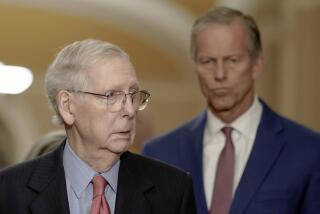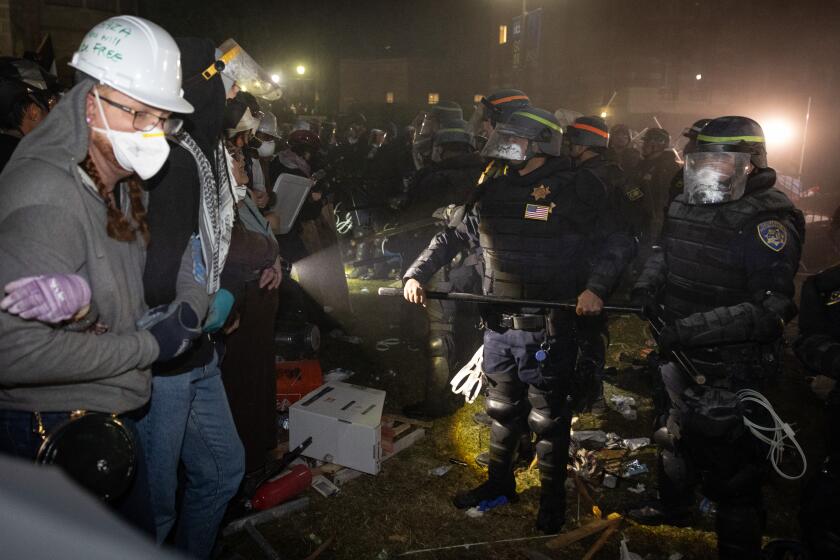Newsletter: Essential Politics: Learning to live with Trump
Both the Republican and Democratic presidential campaigns turned firmly toward the general election to come this week, as GOP congressional leaders started to line up behind Donald Trump, and Hillary Clinton‘s campaign honed a strategy to defeat him.
Good afternoon, I’m David Lauter, Washington bureau chief. Welcome to the Friday edition of our Essential Politics newsletter, in which we look at the events of the week in the presidential campaign and highlight some particularly insightful stories.
A MOVE TOWARD UNITY?
The #NeverTrump movement still has adherents, particularly among GOP intellectuals and columnists. But among elected officials, few want to take the risk of angering constituents who support the presumptive nominee.
So, as Lisa Mascaro reported, Speaker Paul Ryan came under increasing pressure this week to patch up relations with Trump and end a split that was putting Republican members of the House in an unsustainable position. On Thursday, the two men met, and while Ryan did not fully embrace Trump, he said enough conciliatory words for the New York businessman to pronounce himself satisfied.
“Great day in D.C.,” Trump tweeted.
Acquiescence does not equal a warm embrace, of course. Both in Washington and on the state and local level, many elected officials harbor deep doubts about Trump, mistrusting him personally and opposing some of his key policies.
Mark Z. Barabak and Melanie Mason took a close look at some crucial electoral battlegrounds. Trump faces deep problems in several swing states, they report.
Many elected officials also fear he will drag them down in their own races and say they will support “the nominee” without ever mentioning his name. It’s a good bet that the share of Republican officials attending the convention this summer in Cleveland will be well below normal. But as the meeting with Ryan showed, the party establishment is unlikely to lead active opposition to Trump, offering something between grudging acceptance and passive resistance, instead.
Some camps will take a more active role. Thursday brought news of a new pro-Trump super PAC, which, as Seema Mehta reported, that hopes to raise $20 million over the next two months.
The one big exception to the establishment coming to terms with Trump is in the world of Republican foreign policy experts, many of whom see the wealthy New York businessman as a serious threat. On national security, Trump will largely run to the left of Clinton. That could bring some major figures from past Republican administrations to her side, although more likely after the party nominating conventions are over, rather than before.
How all of that will play among voters remains to be seen. Many polls continue to show a significant share of Republicans resistant to Trump. But partisan identity is one of the most powerful forces in American politics. So look for the polls of the November horse race to tighten over the next few weeks as more Republicans find reasons to support their party’s nominee.
IMMIGRATION POLITICS
No issue has been more central to Trump’s campaign than illegal immigration, and his candidacy has continued to roil the debates over that issue.
As Richard Marosi reported, the decision by the union representing Border Patrol agents to endorse Trump has created divisions within the union’s ranks and new tensions between the Border Patrol and immigrant communities.
On the other side of the ledger, Trump’s efforts against illegal immigration have emboldened state officials who share his views. Measures targeting immigrants in the U.S. illegally have sprung up in legislatures around the country, Kate Linthicum reported.
The Obama administration, meantime, plans another round of raids aimed at deporting immigrants who have entered the country illegally from Central America in the past two years. As Linthicum reported, the news angered immigrant advocates and drew protests from Democratic members of Congress as well as both Clinton and Sen. Bernie Sanders.
Homeland Security officials say they have to enforce the law. Behind the move is the concern by administration officials that a new surge of Central American immigrants may be on the way, one that could bolster Trump’s campaign this summer.
CLINTON’S GAME PLAN
At Clinton headquarters in Brooklyn, Trump’s rise set off considerable scrambling earlier this year, as campaign strategists sought to devise a plan for running against a very different Republican nominee than they had originally expected.
As Evan Halper and Mike Memoli reported, the Clinton camp has largely settled on a general election strategy. It’s a “dare to be dull” strategy that calls for Clinton to emphasize her detailed knowledge of policy to draw a sharp contrast with Trump’s theatrical, but policy-weak, style. In the meantime, outside groups allied with Clinton, led by the Priorities USA super PAC, will focus on convincing voters that Trump is unsteady, unserious and an unacceptable risk.
Priorities already has laid plans to spend $130 million in seven key swing states.
The main target for the Democrats’ effort: women, particularly married, white women, in suburban areas of swing states. Married, white women are a group that Mitt Romney won in the 2012 campaign against President Obama. The Clinton strategists believe they can make significant gains among them, offsetting any additional votes that Trump can gain among white men, a group that already votes heavily Republican.
First, of course, Clinton must wrap up her own nomination contest with Sanders. This week, as expected, she lost badly in West Virginia, a state that has moved rapidly to the GOP in federal elections in the years since Bill Clinton won there.
A key issue in West Virginia and neighboring areas of Appalachia is coal and the effort to curb its use to reduce global warming. As Michael Finnegan reported, the future of coal has turned into a major dividing point between the Clinton and Trump campaigns.
Trump hopes to appeal to blue-collar men in industrial-belt states including Pennsylvania and Ohio, which once had significant coal mining regions. Clinton aims her appeals at suburban voters oriented toward environmental protection. The debate over coal has intensified throughout the Obama years, and the 2016 campaign could prove decisive.
Next up comes Oregon, where a recent poll showed Clinton with a significant lead. But as Chris Megerian noted, even the pollster who conducted the survey seemed unsure if the numbers are right.
Clinton needs to win only about one-third of the remaining vote in order to clinch the nomination. She has not scheduled any appearances in Oregon over the next several days.
Her campaign does want to win the final contest of the nominating season, in California on June 7, in part to avoid ending the primaries on a down note. Sanders, who has many supporters among the state’s liberals, would also like to win California. His campaign in the state has had some turmoil, however, recently replacing its state director.
Both in the primaries and the general election, one big problem for Clinton is the perception that she’s a candidate of the past -- perhaps an inevitable image for someone who has prominently figured on the national state for a generation. As Cathy Decker noted, both Sanders and Trump have tried to tie Clinton to the past, reinforcing each other’s messages.
As the remaining primaries play out, we’ll continue to bring you all the results and analyses on Trail Guide and on our Politics page.
And you can keep watch on the delegates in both parties with our Delegate Tracker, which shows where each candidate stands and where each has won support.
IF YOU LIKE THIS NEWSLETTER, TELL YOUR FRIENDS TO SIGN UP
That wraps up this week. My colleague Christina Bellantoni will be back Monday with the weekday edition of Essential Politics. Until then, keep track of all the developments in the 2016 campaign with our Trail Guide at our politics page and on Twitter at latimespolitics.
Send your comments, suggestions and news tips to politics@latimes.com.
More to Read
Get the L.A. Times Politics newsletter
Deeply reported insights into legislation, politics and policy from Sacramento, Washington and beyond. In your inbox three times per week.
You may occasionally receive promotional content from the Los Angeles Times.







